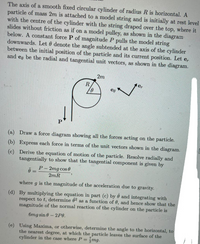Question
Do c d e parts

Transcribed Image Text:The axis of a smooth fixed circular cylinder of radius R is horizontal. A
particle of mass 2m is attached to a model string and is initially at rest level
with the centre of the cylinder with the string draped over the top, where it
slides without friction as if on a model pulley, as shown in the diagram
below. A constant force P of magnitude P pulls the model string
downwards. Let 0 denote the angle subtended at the axis of the cylinder
between the initial position of the particle and its current position. Let
and eg be the radial and tangential unit vectors, as shown in the diagram.
e,
2m
R
er
(a) Draw a force diagram showing all the forces acting on the particle.
(b) Express each force in terms of the unit vectors shown in the diagram.
(c) Derive the equation of motion of the particle. Resolve radially and
tangentially to show that the tangential component is given by
P –
2mg cos 0
%3D
2mR
where
g is the magmitude of the acceleration due to gravity.
(d) By multiplying the equation in part (c) by 0 and integrating with
respect to t, determine 02 as a function of 6, and hence show that the
magnitude of the normal reaction of the cylinder on the particle is
6mg sin 6
- 2P0.
(e) Using Maxima, or otherwise, determine the angle to the horizontal, to
the nearest degree, at which the particle leaves the surface of the
cylinder in the case where P =
mg.
Expert Solution
This question has been solved!
Explore an expertly crafted, step-by-step solution for a thorough understanding of key concepts.
Step by stepSolved in 3 steps with 3 images

Knowledge Booster
Similar questions
arrow_back_ios
arrow_forward_ios